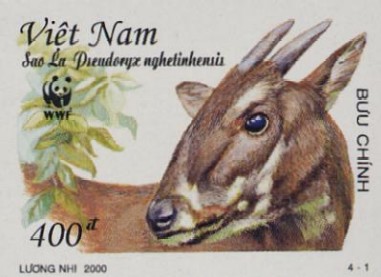
October 15, 2007

Here’s an update on the saola (Pseudoryx nghetinhensis).
Twenty years after its discovery in the forested mountains of Vietnam, local authorities here have agreed to establish new nature reserves to protect a critically endangered wild ox.
As part of a plan to protect the saola (Pseudoryx nghetinhensis), the central Vietnamese provinces of Thua Thien Hue and Quang Nam will create two 121km2 reserves. The reserves will link up with the Bach Ma National Park to cover a continuous protected landscape covering approximately 2,920km2 — stretching from the Vietnamese coast to the Xe Sap National Biodiversity Conservation Area in neighbouring Laos.
“This secures a landscape corridor which is less vulnerable to the impacts of development, climate change and human pressure,” said Dr Barney Long, Central Truong Son Conservation Landscape Coordinator for WWF Vietnam.
“The saola population in Thue Thien Hue and Quang Nam provinces offers the best, if not the only, chance for this unique flagship species to survive.”
Found only in the Annamite Mountains of Vietnam and Laos, the saola was discovered in 1992 by a team of scientists from the Vietnamese Ministry of Forestry and WWF; the first large mammal to be discovered anywhere in the world since 1936.
The saola is a primitive member of the Bovidae family, which includes antelopes, buffalo, bison, cattle, goats and sheep. Although very little is known about the species, its global population is thought to be no more than 250 individuals, and its distribution highly restricted to only six provinces in Vietnam and four in Laos. The largest population is found in the far south of the saola’s distribution range in Vietnam on the border between Thua Thien Hue and Quang Nam provinces where the nature reserves will be established.
Other species that will be protected by this enhanced green corridor include the Truongson muntjac, red-shanked douc and white-cheeked crested gibbon, as well as many other newly and yet to be described species.
Recently WWF announced the discovery of 11 new species of animals and plants in this remote area of Vietnam, including butterflies, orchids and a snake.
“The saola acts as an emblem of conservation efforts in Vietnam, yet it remains on the brink of extinction,” added Tran Minh Hien, WWF Vietnam’s Programme Director.
“We are committed to supporting local agencies to develop locally appropriate interventions to ensure its survival.”Science Daily release, from WWF data.
About Loren Coleman
Loren Coleman is one of the world’s leading cryptozoologists, some say “the” leading living cryptozoologist. Certainly, he is acknowledged as the current living American researcher and writer who has most popularized cryptozoology in the late 20th and early 21st centuries.
Starting his fieldwork and investigations in 1960, after traveling and trekking extensively in pursuit of cryptozoological mysteries, Coleman began writing to share his experiences in 1969. An honorary member of Ivan T. Sanderson’s Society for the Investigation of the Unexplained in the 1970s, Coleman has been bestowed with similar honorary memberships of the North Idaho College Cryptozoology Club in 1983, and in subsequent years, that of the British Columbia Scientific Cryptozoology Club, CryptoSafari International, and other international organizations. He was also a Life Member and Benefactor of the International Society of Cryptozoology (now-defunct).
Loren Coleman’s daily blog, as a member of the Cryptomundo Team, served as an ongoing avenue of communication for the ever-growing body of cryptozoo news from 2005 through 2013. He returned as an infrequent contributor beginning Halloween week of 2015.
Coleman is the founder in 2003, and current director of the International Cryptozoology Museum in Portland, Maine.
Filed under Breaking News, Cryptotourism, CryptoZoo News, Cryptozoologists, Cryptozoology, Extinct, New Species